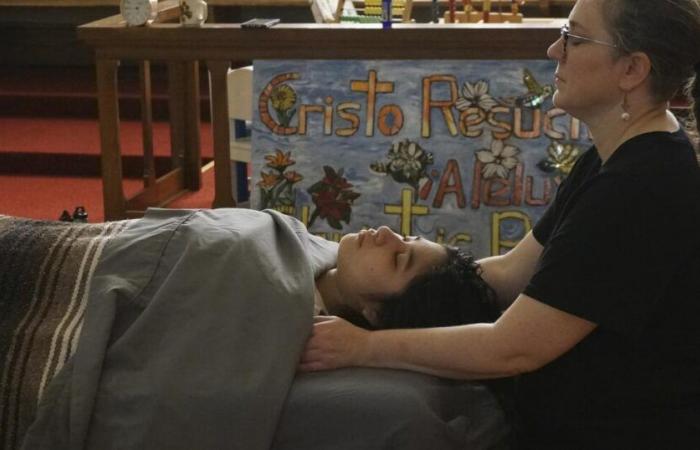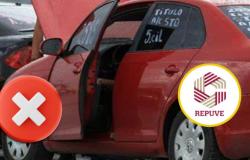Minneapolis, Minnesota, Yes. — — Immediately after the Sunday cult in the Lutheran Church of San Pablo, Juan Carlos Toapanta lay in a rest armchair placed next to the altar, with needles stuck in the forehead, the doll and the foot, for a one -hour acupuncture session.
“It feels like a privilege: as much as the Lord’s light emotionally helps, it is also the pain of the body,” said this Ecuadorian construction worker, who suffers from sciatica and has attended the Church of Minneapolis for about five months. “Everything is released, emotionally.”
Founded by Swedish immigrants at the end of the 19th century, the Church is now a predominantly Latin congregation. Like most other churches in the United States that serve immigrants, it has expanded its humanitarian, financial, legal and pastoral ministry during Trump’s government’s immigration repression.
He has also added monthly welfare sessions – without cost – with acupuncture, reiki and suction therapy to relieve stress that uncertainty and fear have sown among the immigrant community – which includes people residing in the United States without legal authorization and citizens born in that country in families with mixed immigration status.
Faithful that come to the Lutheran Church San Pablo receive acupuncture treatment in the sanctuary after having made a prayer, in Minneapolis, on Sunday, April 27, 2025.
(Giovanna dell’Orto/AP)
“We have to be well to answer well – not with panic and fear. Fear does not give anything good,” said Vega, who has headed the well -being initiatives as a coordinator of Latin scope of the Church. “The person feels that he is protected and can be spiritually, emotionally and physically.”
Increases collaboration between mental health and religious ministry
Religious leaders, from chaplains in the United States navy to shepherds in rural areas, have been increasingly called to help their congregations with mental health problems.
Some see the need to provide comfort and well -being as a growing part of their ministry to immigrants, even when federal updated immigration guidelines now offer greater maneuvering margin for the application of the law in or near the places of worship.
“It was as if they could exhale deeply,” said the Horald Osorto reverend on the 30 parishioners who registered for the first welfare session in March in the church of San Pablo, where an outdoor mural presents two traditional Swedish horses of Dalecarlia between the words “healing” and “resilience” in Spanish.
At the end of last Sunday’s cult, the Altar table and the Easter lilies were relocated to accommodate seven acupuncture chairs, arranged in a circle in front of the central cross. Three massage stretchers were installed in front of the banks for the treatment of Reiki, in which practitioners place their hands on or near the body’s energy centers.
“Seeing this space literally turned into a place of healing, where we talk about it right on the altar, it moved me to tears,” Osorto confessed.
The increase in anxiety and confusion affects mental health and well -being of immigrants
Welfare professionals and mental health professionals affirm that anxiety and depression among those who attend in immigrant communities have extended and intensified this year.
Immigrants often arrive with serious traumas due to the violence they fled in their countries of origin, as well as for the attacks on the routes controlled by the cartels towards the US border.
Women, in particular, usually suffer sexual assault during the trip. For many, the fear that they or a relative is deported is a revictimization. Therefore, it is imperative that there are “safe places” where they can focus on their well -being, said Noeline Maldonado, executive director of The Healing Center (the Healing Center), which helps victims of domestic and sexual violence in Brooklyn, New York.
The sessions that promote spiritual rooting and full attention are necessary to face the stress of both immediate crises and long -term uncertainty as migratory policies change.
“Uncertainty is the most important thing,” said Cheryl Aguilar, director of the Hope Center for Wellness (Hope for Welfare Center) in the Washington area, DC, which has been associated with Churches to offer mental health programs.
Being in community and cultivating hope is crucial because many people respond to fear with an increase in anxiety, traumatic symptoms and isolation, all of which can have lasting consequences, Aguilar added.
“It is a constant work, a constant fear,” said Sarah Howell, a clinical social worker in Houston with more than a decade of experience in traumas related to immigration. “Each problem seems bigger.”
Howell commented that many of their clients in Texas have realized that they cannot live in a constant alarm state, and the relief provided by well -being programs becomes essential.
Find healing in places of worship
“They feel without hope, but they have to fight,” said Guadalupe González, one of Reiki’s bilingual practitioners whose organization, Odigo Wellness (guide welfare), associated with the church of San Pablo in Minneapolis to offer the sessions.
He added that he had some reserves about making healing practices within the Church – a large space flooded with natural light and people circulating.
But “the sanctuary has a very beautiful, very positive energy,” González said. “We feel many emotions.”
Several parishioners who attended the two -hour welfare session last Sunday said they experienced both the energy and the connection between these healing practices and faith.
Martha Domínguez went down with the altar stairs after an acupuncture session. He smiled and explained that he had never imagined a church that offered this type of “benefits.”
“Yes: it helps so much,” said the Mexican immigrant. “Stress (se) takes one away.”
Limber Saliero, a roof from Ecuador who has made the church of San Pablo his place of worship for five years, reported that he had never heard about acupuncture, but decided to try it.
“I felt like an energy that was entering,” he said.
Vanessa Arcos tested acupuncture with her sister and father, while her mother received a reiki treatment. The family began to attend the Church the week that arrived in Minnesota from their native state in Guerrero, Mexico, almost a decade ago.
Lying in a rest armchair next to a statue of the Virgin of Guadalupe, Arcos confessed that he overcame his fear of the needles, and that he found the relaxing treatment for both the muscles and the mind.
“I felt very in peace, very safe,” said Arcos. “It is important to do little things for oneself.”
___
The religious coverage of The Associated Press receives support through the collaboration of the AP with The Conversation Us, with financing from Lilly Endowment Inc. the AP is solely responsible for this content.






